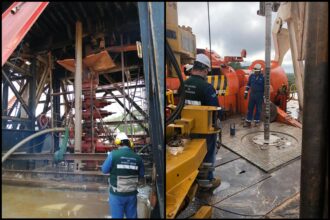Introduction to Shape:yl6axe4-ozq= Pentagon
The shape:yl6axe4-ozq= pentagon is a term that piques curiosity and stirs intrigue. At first glance, one might wonder what lies behind this unique nomenclature. The pentagon is more than just a geometric figure; it represents an essential element in modern governance, military strategy, and international relations.
As we journey through the various facets of the shape:yl6axe4-ozq= pentagon, you’ll uncover its historical significance, organizational structure, and impact on today’s world. Whether you’re a history buff or simply curious about global affairs, there’s much to explore within this iconic institution’s walls. Let’s dive into the compelling story of the shape:yl6axe4-ozq= pentagon!
What is Shape:yl6axe4-ozq= Pentagon?
The Shape:yl6axe4-ozq= Pentagon is a pivotal entity in military and defense strategy. It serves as the headquarters for the United States Department of Defense. This iconic structure symbolizes American military power.
Unlike traditional organizations, it operates on a vast scale. The Pentagon houses various branches of the armed forces, including the Army, Navy, Air Force, and Marine Corps.
Its unique five-sided design not only maximizes space but also facilitates efficient communication among different departments. Within its walls are strategic planning rooms that oversee global operations.
More than just an office building, it’s a center for decision-making during crises. The Shape:yl6axe4-ozq= Pentagon plays a crucial role in shaping U.
S. defense policies and international relations. Its influence extends far beyond its physical boundaries into global security dynamics.
Understanding the History and Purpose of Shape:yl6axe4-ozq= Pentagon
The Shape:yl6axe4-ozq= Pentagon has a rich and complex history. Established during World War II, it was designed as a response to the need for improved military coordination. The structure symbolizes power and resilience.
Initially, its purpose was to serve as the headquarters for the United States Department of Defense. Here, strategic decisions could be made more efficiently in one central location. This innovation transformed how military operations are conducted.
Over time, the Pentagon evolved beyond just a military hub. It became an iconic representation of national security and defense strategy. Each corner holds stories of bravery, sacrifice, and determination that shape our understanding of global peacekeeping efforts.
Its design reflects functionality while also being steeped in symbolism. The five-sided layout is not only practical but also signifies unity among different branches of armed forces working towards common goals.
The Role of SHAPE in Today’s World
SHAPE plays a crucial role in today’s complex security landscape. As an integral part of NATO, it collaborates with member nations to enhance mutual defense strategies. This collaboration is essential for addressing emerging threats.
In recent years, SHAPE has adapted its focus to include cyber warfare and terrorism. These modern challenges require innovative solutions and proactive measures. By fostering partnerships among countries, SHAPE strengthens collective resilience against such threats.
Additionally, SHAPE promotes joint training exercises that improve interoperability between military forces. This ensures that when crises arise, troops can work seamlessly together.
Moreover, the organization emphasizes humanitarian missions alongside traditional military operations. By engaging in disaster relief efforts and peacekeeping tasks, SHAPE showcases its commitment to global stability while building trust among nations.
The dynamic nature of international relations means that SHAPE must continue evolving to meet future challenges effectively.
Key Members and Structure of the Organization
The Shape:yl6axe4-ozq= Pentagon is governed by a diverse group of leaders. Each member brings unique expertise and experience to the table. This variety enhances decision-making and strategic planning.
At the top, you’ll find senior officials who oversee major operations. They set the direction for various initiatives while ensuring alignment with organizational goals.
Beneath these leaders are specialized teams focusing on different sectors like intelligence, logistics, and human resources. These teams work collaboratively to implement policies that support overall missions.
Moreover, advisory committees play a crucial role in shaping strategies. Their insights help navigate complex challenges facing the organization today.
This structured approach allows for both efficiency and adaptability in an ever-changing landscape. The blend of leadership styles enriches discussions and fosters innovation throughout all levels of the organization.
Achievements and Impact of SHAPE
SHAPE, or Supreme Headquarters Allied Powers Europe, has made significant strides since its inception. It plays a pivotal role in coordinating military operations among NATO allies. Through effective collaboration and strategic planning, SHAPE enhances collective defense mechanisms.
One of its most notable achievements is the successful integration of forces from diverse nations. This unity fosters stronger relationships and better operational readiness across member states. By conducting joint exercises, SHAPE ensures that troops are well-prepared for any eventuality.
Additionally, SHAPE contributes to crisis management through its rapid response capabilities. Its involvement in humanitarian missions showcases commitment beyond traditional military roles.
The organization also prioritizes innovation by embracing new technologies and modern warfare tactics. This proactive approach helps maintain security while adapting to evolving global threats.
Through these efforts, SHAPE significantly influences both regional stability and international security initiatives within NATO’s framework.
Criticisms and Controversies Surrounding Shape:yl6axe4-ozq= Pentagon
The Shape:yl6axe4-ozq= Pentagon has faced its share of criticisms over the years. Some argue that its vast military influence often overshadows diplomatic efforts. Critics believe this can lead to an aggressive foreign policy, prioritizing military solutions rather than peaceful negotiations.
Transparency is another area of concern. Many citizens feel there’s a lack of openness regarding decision-making processes and budget allocations. This perception breeds distrust among the public and even within allied nations.
Additionally, issues surrounding personnel management have surfaced. Allegations about discrimination or inadequate treatment of service members occasionally arise, challenging the organization’s image as a leader in military ethics.
Debates on resource allocation also persist, especially when funds are directed towards advanced weaponry instead of crucial social services for veterans or active-duty personnel. These controversies highlight essential discussions around priorities in national security versus community welfare.
Potential Future Developments for the Organization
The future of the shape:yl6axe4-ozq= pentagon is poised for intriguing developments. As global dynamics shift, innovative strategies will likely emerge to enhance its operational efficiency.
Adopting new technologies could redefine how the organization collaborates and communicates. Advanced data analytics may provide deeper insights into decision-making processes.
Increased focus on sustainability might also play a pivotal role in shaping its initiatives. Embracing eco-friendly practices can strengthen its commitment to environmental responsibility.
Furthermore, expanding partnerships with international organizations could foster greater cooperation on security matters. This evolution would help address emerging threats more effectively.
As geopolitical landscapes evolve, adapting protocols will be crucial. The organization must remain agile to respond swiftly to unforeseen challenges while maintaining stability within its ranks.
Conclusion
The shape:yl6axe4-ozq= pentagon remains a significant entity in global affairs. Its influence stretches far beyond military operations, affecting diplomatic relations and international policies.
As we look towards the future, the organization is poised to adapt to emerging threats and challenges. This adaptability will define its relevance in an ever-changing world.
Engagement with new technologies and collaborative efforts could reshape its strategies. The focus on innovation may lead to groundbreaking approaches within global defense frameworks.
Understanding this dynamic environment is crucial for stakeholders involved. Awareness of how these developments unfold can help navigate potential uncertainties ahead.
The ongoing evolution of the shape:yl6axe4-ozq= pentagon invites curiosity from various sectors, including policy makers, analysts, and citizens alike. Each plays a role in shaping perceptions around this pivotal institution.
FAQs
Q: What is the Shape:yl6axe4-ozq= Pentagon?
A: The Shape:yl6axe4-ozq= Pentagon refers to a complex organization that plays a vital role in international security and military operations. It serves as the headquarters for NATO operations, focusing on collaborative defense efforts.
Q: How did the Shape:yl6axe4-ozq= Pentagon originate?
A: The origins of the Shape:yl6axe4-ozq= Pentagon can be traced back to post-World War II when there was an urgent need for collective defense among European nations. The structure aims to foster cooperation and coordination among member states.
Q: Who are key members of the Shape:yl6axe4-ozq= Pentagon?
A: Key members typically include representatives from NATO countries, along with top military officials who work together towards achieving common strategic goals. This diverse team contributes different perspectives and expertise.
Q: What impact has the Shape:yl6axe4-ozq= Pentagon had globally?
A: The impact is significant, influencing global peacekeeping efforts and crisis management strategies. Through various missions, it has helped stabilize regions afflicted by conflict.
Q: Are there controversies surrounding the Shape:yl6axe4-ozq= Pentagon?
A: Yes, criticisms often arise regarding its actions in certain conflicts and its overall effectiveness. Some argue about transparency issues or question whether all member states receive fair representation.
Q: What does the future hold for SHAPE?
A: As geopolitical landscapes change, so too will its strategies and focus areas. Potential developments might involve enhanced cyber capabilities or deeper collaborations outside traditional military alliances.
These questions shed light on what makes shape:yl6axe4-ozq= pentagon an intriguing subject worth exploring further!

















